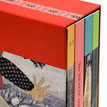| Francis M. Naumann |
A Problem with
No Solution |
In 1943, Marcel Duchamp was asked by the gallery owner Julien Levy to
design the announcement for an exhibition to be called “Through the
Big
End of the Opera Glass.”¹ As the title implies (adapted, as it was,
from
Lewis Carroll’s Through the Looking Glass), the show was to feature
unusually
small-scale work. Years later, Levy explained that the idea for the exhibition
came from having seen an example of Duchamp’s valise, in which
the artist had packed miniature reproductions of his work into a portable
suitcase.² The show was to include not only
work by Duchamp, but by two other artists as well: the French Surrealist
painter Yves Tanguy, and the American collage and assemblage artist, Joseph
Cornell. Within the announcement (Fig. 1), Duchamp reproduced a black-and-white
layout by Cornell featuring the titles of Cornell’s work printed in a variety
of expressive
type faces surrounded by a collage of images referring to them, while
Tanguy was represented by a drawing of one of his characteristically biomorphic
three-dimensional shapes, accompanied, in this particular
instance, by an opaque black shadow that curiously overlaps it.
For his own contribution, on the back cover of the announcement
Duchamp provided the image of a cupid with a stretched bow and arrow
in his hands, but the figure is inexplicably reproduced upside down, for
the
artist’s signature—which is oriented legibly—streams
off to one side at
the level of the cupid’s head. At first glance, knowing that Duchamp
often
appropriated imagery for whatever purpose was required—in the fashion
of culling images readymade—one might easily conclude
that the cupid was clipped from some printed
source and collaged into this position. However, the
original layout for this announcement was recently discovered
among the effects of Julien Levy, and it is now
known that Duchamp painstakingly drew the cupid
himself in pen and ink (Fig. 2). It is likely that he took
the time to render this image because he could not find
the reproduction of a cupid fixing his arrow in this precise
direction, a detail that, as we shall soon learn, is
critical to his intent, for the significance of the cupid’s
aim can only be understood when the announcement is
unfolded and fully opened.
1. The date of this exhibition has been given variously, as either 1943
or 1948. Julien Levy
consistently gave the date as 1943 (see his autobiography, Memoir
of an Art Gallery [New
York: G.P. Putnam’s Sons, 1977], p. 309, as well as the reference
contained in the following
note). For reasons that are unclear, however, in all editions of his otherwise
reliable
catalogue raisonné of work by Marcel Duchamp, Arturo Schwarz gives
the date as 1948
(see The Complete Works of Marcel Duchamp [New York: Harry N. Abrams, 1969],
cat.
no. 329, page 523; revised and expanded edition [New York: Delano Greenidge
Editions,
1997], cat. no. 530, p. 793, and descriptive bibliography 71, page 904).
The date of 1943
cannot be challenged, however, for the show was reviewed in The
New York Times on
December 12, 1943 (I am grateful to Ingrid Shaffner for bringing this citation
to my
attention).
2. See the statement provided by Julien Levy for a brochure published
on the occasion of
“Through the Big End of the Opera Glass II,” a recreation of
the original 1943 show at
the Joan Washburn Gallery, New York, February 15 -March 12, 1977 (the brochure
contained
a facsimile reprint of the original fold-out catalogue).
—
FRANCIS M. NAUMANN is an independent scholar, curator and art dealer,
specializing
in the art of the Dada and Surrealist periods. He is author of numerous
articles and exhibition catalogues, including New
York Dada 1915-25 (Harry
N.
Abrams, 1994), Marcel Duchamp: The Art of Making Art in the Age of Mechanical
Reproduction (Harry N. Abrams, 1999), Wallace
Putnam (Harry N. Abrams,
2002) and, most recently, Conversion to Modernism: The Early Work of
Man Ray
(Rutgers University Press, 2002). In 1996, he organized “Making
Mischief: Dada
Invades New York” for the Whitney Museum of American Art, and in
1997, “Beatrice
Wood: A Centennial Tribute” for the American Craft Museum in New
York.
He is preparing for publication a selection of his essays on Marcel Duchamp,
and
currently owns and operates his own gallery in New York City.
For the complete article purchase The Sienese Shredder #1
Also by Francis M. Naumann
Florine Stettheimer's Hand-Painted China Plates
Back to The Sienese Shredder #1
| 

